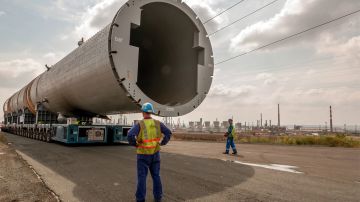Following the economic downturn of 2009, 2010 saw a marked improvement in INEOS’ trading results; a trend that has continued through the first half of 2011. But as confidence in the global economy has fallen in the second half of the year and demand has softened what does 2012 hold for the company? As 2011 draws to a close, John Reece shares his view.
INEOS knows how to handle itself in a recession. When the downturn hit in 2008/2009, the company moved quickly to manage its cash and costs. Anything that was controllable was tightly managed. The company was in reasonable shape when the economic downturn washed across most, if not all of its markets.
Having reduced costs, improved efficiencies and reduced levels of working capital, when things recovered it was said by some that INEOS 'slingshot out of the recession.'
“Between 2009 and 2010 we took €200m out of Fixed Costs and we have not let that come back, which is one of the reasons that we continue to be successful.”John Reece, Financial Director, INEOS AG.
Performance in 2010 proved this to be true, with the earnings for the year 70% ahead of 2009. As demand continued to strengthen it seemed that 2011 would also break records. In fact the first half did. INEOS had two record quarters and by September it was already well ahead of 2010. Results for the first half of 2011 were better than the whole of 2009.
The structure of the company also fundamentally strengthened in 2011. In July the deal with PetroChina completed, setting up a Refining Joint Venture with one of the largest companies in the world. This was a hugely transformational deal for the group, paying down $1bn of bank debt, which helped further reduce leverage from 4.4 times EBITDA to about 3.5 times EBITDA.
“The thing about refining is everything is ten times the size of our other businesses so the Working Capital swings are ten times the size, the CapEx is ten times the size. Taking Refining out of the group into a separate financing structure makes a huge difference, which is why PetroChina it is a transformational deal,”said John.
INEOS put in a very strong performance in the first half of 2011, but this was to be turned on its head in the second half. As a significant proportion of the company’s products go into consumer durables the business tends to track Gross Domestic Product (GDP). And as confidence in world economies began to fall in the summer it was no surprise to see demand, margins and earnings from INEOS products significantly reduce.
In Europe, concerns about Sovereign Debt and the potential impacton the Euro has created uncertainty and softened demand. Demand has also reduced in North America but the region continues to present good earnings, partly resulting from the availability of low-cost shale gas. 50% of this year’s EBITDA has come in from the US and this is expected to continue to be the same going forward.
In China, manufacturing activity contracted for the first time in almost three years in November, adding to fears about the health of the global economy, but INEOS expects growth in this market to remain relatively strong by global standards. China’s economy expanded 9.1 per cent in the third quarter, slower than 9.5 per cent in the second quarter but an enviable growth rate.
“We expect growth in Asia to continue long-term despite some inevitable slow down, currently,”comments, John.
“Beijing has kicked off a new round of monetary easing after more than two years of progressively tighter policies. By cutting the amount of deposits that their banks must hold in reserve with the central bank it will ease constraints on lending; the equivalent of injecting around $63bn into the economy.”
INEOS is already well placed in Northern Europe and North America and is now looking to the Far East. Another advantage of the PetroChina deal is that the two companies now have a very good relationship and the two plan to broaden this further by looking to widen interest into other INEOS products.
Global economic and political turbulence has created hesitancy in many markets, leading to a softening in demand in a number of sectors towards the end of this year. INEOS reported that EBITDA for the third quarter of 2011 was €371m, compared to €464m for Q3, 2010 and €576m for Q2, 2011.
“Demand in Q4 has continued to be weak and we expect more of the same in Q1 and Q2 before things slowly start to pick up, in the second half of the year,”said John.“At this point we see 2012 as a year of standing still on the headline EBITDA. But if you look at our numbers of reduced Capital expenditure and the benefit of reduced tax in Switzerland, we will still produce cash and pay down some debt which is our main objective.”
Another key objective, if we ever get a stable credit market, is to get out and refinance. We would certainly want to do that in 2012.
“I think once we get into 2012 we are focused on achieving a refinancing and that will be a function of the credit markets and it is difficult to call at the moment, as you have seen with what is going on in Greece, the credit markets are much more volatile than the chemical markets but we believe that they will improve. There is a lot of liquidity coming into the US High Yield Market and therefore we need to think about refinancing certainly Q2 of next year I would say.”
John concludes:“INEOS is a business that is closely linked to GDP. Our commodity chemicals either end up as consumables or durables so we are always exposed to global demand, but we have been stress tested in the worst recession that we have seen in 30 years and we are still here and our financial position is better today than it was going into that in 2008. We have to ride the economic cycle, there is no question of that but I think that we are in good shape to do it.”
















